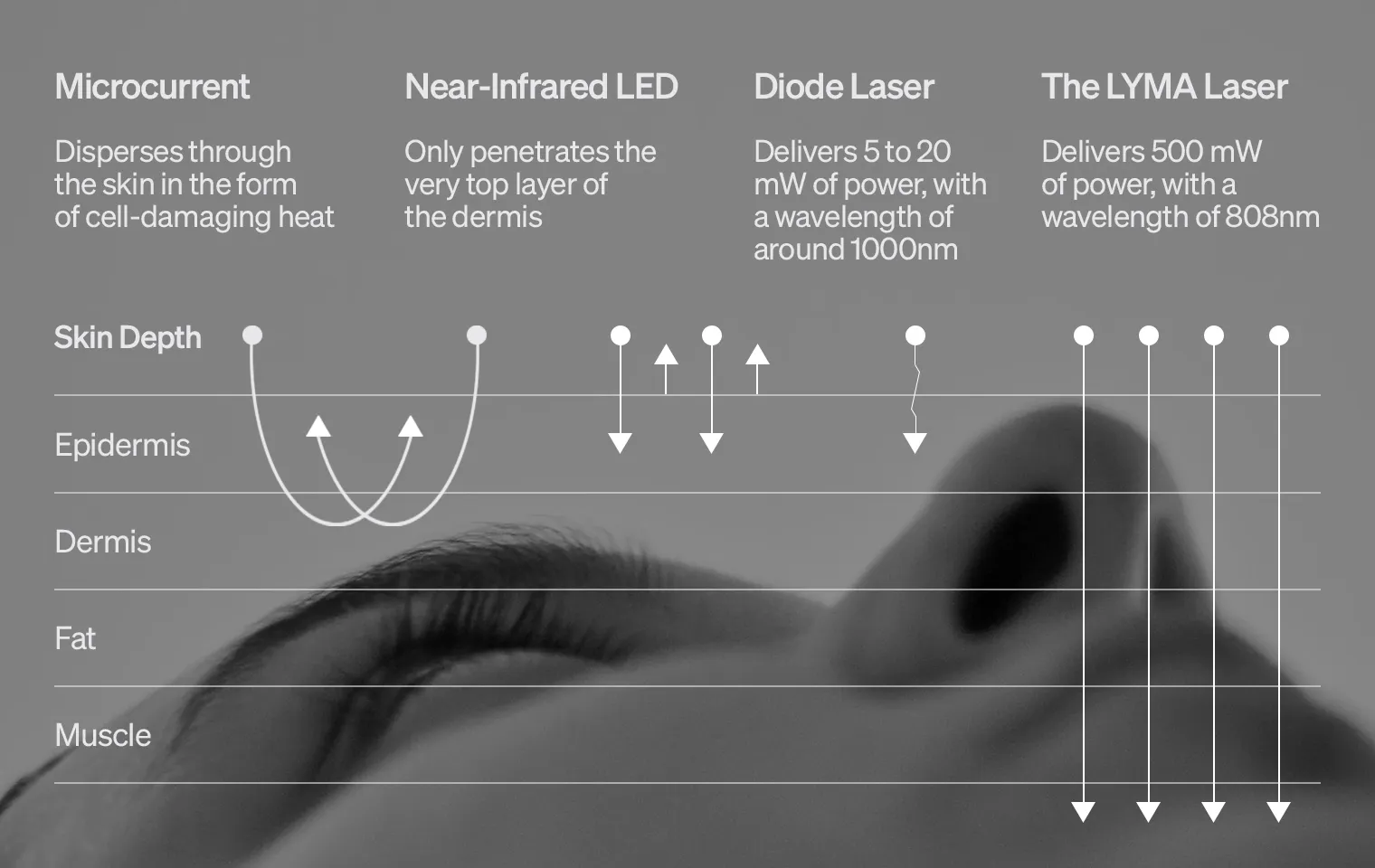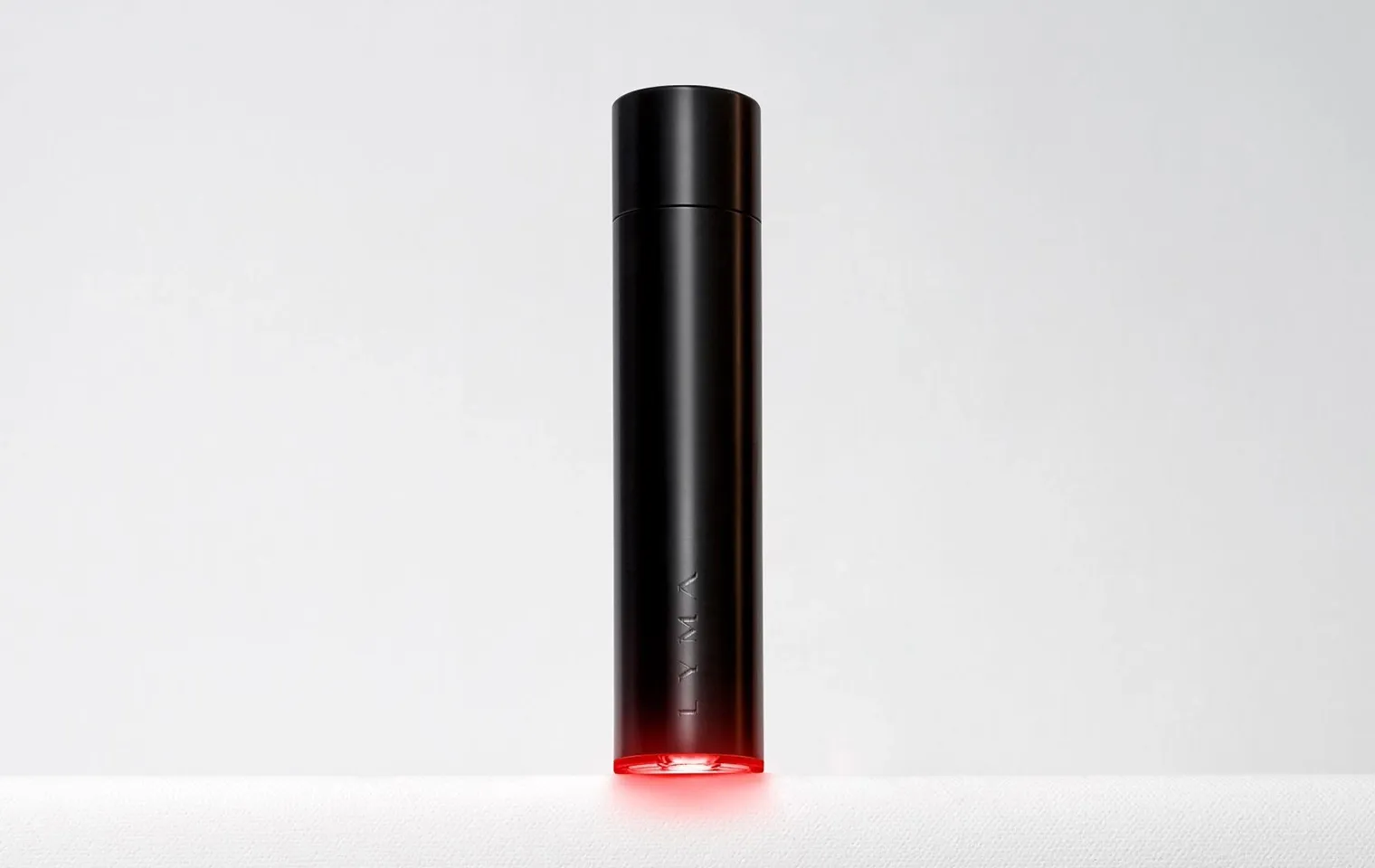8 Minute ReadReport by Jessica Lacey, Health & Beauty Expert
06.12.23 (Updated 06.03.24)
“We do not make unsubstantiated claims about the LYMA Laser and we work with some of the world’s most renowned doctors, dermatologists and experts, all who have reviewed the LYMA Laser and credit the device for its ground-breaking technology,” says LYMA founder Lucy Goff who is well accustomed to answering the most meticulous of questions about the LYMA Laser. After all, when you produce never-before-achieved technology, it comes with the new territory.
These two lasers are often compared as to which is the best at-home skin laser and indeed, when searching for Nira laser alternatives, the LYMA Laser will often come up first. Both devices offer consumers choice based on what they are hoping to achieve and what they are trying to treat.
LYMA LASER | NIRA LASER | |
TYPE OF LASER TECHNOLOGY | Near-infrared cold laser | Non-fractional, non-ablative laser |
HOW IT WORKS | Rejuvenates the skin by switching on skin’s innate cell regeneration capacity | Heats the water content of the dermis causing the release of stress proteins |
WAVELENGTH | Operates comfortably within the therapeutic treatment window for cellular stimulation | Operates well outside the therapeutic treatment window for any cellular interaction |
FDA CLEARANCE STATUS | FDA cleared for wrinkles and aging across the entire face | FDA cleared only for periorbital wrinkles around the eye area |
SCIENTIFIC EVIDENCE | Over 50 independent medical research papers published on LLLT | 1 clinical trial of 76 people carried out by the Nira brand |
Proof: There are now more than fifty medical papers written by scientists across the globe on the transformative cosmetic aptitude of LLLT - the weight of scientific proof behind LLLT and the LYMA Laser dwarfs that of the one Nira clinical trial of 76 people.
Power: The scientifically proven necessary therapeutic dose for skin treatment is 4 Joules The LYMA laser emits 4 Joules in 60 seconds at an 8cm2 area. The Nira Laser uses pulses delivering between 2.2 and 3 joules per 1 cm2 of energy per pulse.
Performance: The Therapeutic Optical Window sits in the wavelength range of 600-1000 nm where you can reach the treatable human tissue and have the required stimulating effect.
LYMA Laser operates directly in the middle of that ideal range of cellular stimulation at 808 nm. In contrast, the wavelength of the NIRA Precision Laser is 1450 nm - considerably, outside of the therapeutic window. This means the minimal 3 to 4 Celsius increase of heat is absorbed mostly by water in the skin, rather than interacting with any skin cells.
| NIRA PRECISION LASER | LYMA LASER | |
| TRIGGERS HSP (HEAT SHOCK FORMATION) | ✔ | ✘ |
| INFLICTS FOCUSED HEAT ON SKIN | ✔ | ✘ |
| OPERATES WITHIN THERAPEUTIC TREATMENT WINDOW | ✘ | ✔ |
| SWITCHES GENE EXPRESSION TO INCREASE SKIN REGENERATION | ✘ | ✔ |
| FDA APPROVED FOR FULL FACE | ✘ | ✔ |
| ZERO RISK OF POST-INFLAMMATORY HYPERPIGMENTATION | ✘ | ✔ |
| ZERO DAMAGE TO SKIN | ✘ | ✔ |
| REDUCES INFLAMMATION IN SKIN | ✘ | ✔ |
| SUITABLE FOR HIGHLY SENSITIVE SKIN | ✘ | ✔ |
| EASE OF USE ANYWHERE, ANYTIME | ✘ | ✔ |
| INCREASES SKIN STRENGTH & HEALTH | ✘ | ✔ |
| PROVEN TO WORK BY INDEPENDENT MEDICAL PROFESSIONALS | ✘ | ✔ |
| 2 YEAR FULL WARRANTY | ✘ | ✔ |
How the NIRA Laser works, courtesy of globally renowned facial and limb reconstructive surgeon, Dr Graeme Glass.
“Specifically, the Nira diode laser operates at a wavelength of 1450nm to heat the water content of the dermis. The cells of the dermis recognise this localised rise in temperature as a threat and respond in the same way as when exposed to toxins such as alcohol or lack of oxygen. They release heat shock proteins (HSP, otherwise known as stress proteins). However, while they are implicated in tissue repair and regeneration by virtue of being induced by tissue injury (or threat thereof), this primordial system has long since been improved and replaced by the adaptive immune systems. So, while heating the water content of the dermis causes the release of stress proteins, it is disingenuous to infer that this is a state-of-the-art means of inducing tissue regeneration. Rather, it is a phenomenon that serves to demonstrate the complexity and redundancy built within the human genome by the long, slow climb of evolution spanning the entire story of life on earth.”
The LYMA Laser is a cold laser device that empowers skin into renewal. Rather than heat the skin, the near infrared low level laser therapy (LLLT) of the LYMA Laser operates at exactly the power and wavelength to produce a medically documented process called Photobiomodulation.
The LYMA Laser has been engineered to diffuse the central laser beam so the heat from the light is removed by the time it enters the skin. Cold laser light is the only light which causes laser speckle which has a biological effect inside the body. Powerful light energy is transferred directly into the nuclei of skin cells to increase the production of ATP by supercharging the mitochondria (the battery packs of cells), leading to a significant increase in cell activity and skin repairing and rejuvenating itself at a faster rate. Collagen production increases naturally, skin is made stronger, more resilient and operates optimally once more. Zero heat, zero damage, just 100% medically proven cellular regeneration.
The LYMA Laser has FDA-clearance for wrinkles and aging across the entire face, the NIRA Laser is only FDA cleared for periorbital wrinkles around the eye area. A 510K clearance is granted on the basis of “substantial equivalence” to products that are already on the market.
Our legal advisors used a current LED-based device on which to base the application as both they and the FDA acknowledged that there was nothing more similar to the LYMA Laser on the market. The use of the term “substantially equivalent” is legal parlance and was never intended to be misrepresented as a measure of the relative efficacy of the LYMA Laser.

Tens of thousands of doctors have treated millions of patients with LLLT (Low-level Laser Light Therapy) for over six decades. What originated as a medical laser used to rebuild cartilage and muscle in rehabilitation centers, led to the creation of the Laser Research Centre and LLLT being harnessed for cosmetic purposes, as with the LYMA Laser.
There are clear distinctions between laser therapy and light therapy and yet, so much confusion remains. Low-level Laser Therapy uses the exact same medical abbreviation as Low-Level Light Therapy. Both are LLLT, only one is referring to powerful, straight-line laser beams and the other, a much weaker and differently formed light source.
“When you're in an immature research environment like skin laser technology, lots of different terms are bandied about because no one quite knows what to call everything yet,” says leading Craniofacial, Aesthetic and Plastic Surgeon, Dr Graeme Glass.
To be abundantly clear, the LYMA Laser harnesses the power of low-level Laser technology - it is ‘laser’ therapy, not ‘light’ therapy. The LYMA Laser is a Laser device with LEDs in its lens but these are merely indicator lights to display that the device is switched on.

The LYMA Laser penetrates all layers of skin down to fat and muscle. Yet absorption in human tissue is exponential, so even though the infrared laser light reaches the deeper tissues too, the majority of it is absorbed in the dermis and epidermis where the antiaging, skin boosting benefits can be reaped. LLLT is scientifically documented to improve muscle tone for a lifting effect, accelerate healing in damaged tissues, promote cellular metabolism and reduce inflammation.
Before you invest in any at-home skin laser, it’s imperative that you do your research, ask the experts and find out the truth. It’s your skin, your time and your expectations that need to be met. LYMA will continue to lobby for more transparency and regulation in the industry but until that’s realized, the truth can be somewhat murky. Any valid company should be proud to show off their science and produce their research, which is why you can email concierge@lyma.life with any questions and they will be answered honestly, factually and with the scientific evidence to back it up.
de Freitas, Lucas Freitas, and Michael R. Hamblin. ‘Proposed mechanisms of photobiomodulation or low-level light therapy’, IEEE Journal of selected topics in quantum electronics 22.3 (2016): 348-364.
Glass, G. E. (2021). ‘Photobiomodulation: the clinical applications of low-level light therapy’ Aesthetic Surgery Journal, 41(6), 723-738.
Keshri, Gaurav K., et al. ‘Photobiomodulation with pulsed and continuous wave near-infrared laser (810 nm, Al-Ga-As) augments dermal wound healing in immunosuppressed rats’ PloS one 11.11 (2016): e0166705.
Topaloglu, Nermin, Merve Özdemir, and Ziyşan Buse Yaralı Çevik. ‘Comparative analysis of the light parameters of red and near‐infrared diode lasers to induce photobiomodulation on fibroblasts and keratinocytes: An in vitro study’ Photodermatology, Photoimmunology & Photomedicine 37.3 (2021): 253-262.
ÖZDEMİR, Merve, Ziyşan Buse YARALI ÇEVİK, and Nermin TOPALOĞLU ‘The effect of
photobiomodulation with red and near-infrared wavelengths on keratinocyte cells’ 2020 Medical Technologies Congress (TIPTEKNO). IEEE, 2020.
Güngörmüş, Metin, and Utkan Akyol. ‘The effect of gallium-aluminum-arsenide 808-nm low-level laser therapy on healing of skin incisions made using a diode laser’ Photomedicine and laser surgery 27.6 (2009): 895-899.
Zare, Fatemeh, et al. ‘Photobiomodulation with 630 plus 810 nm wavelengths induce more in vitro cell viability of human adipose stem cells than human bone marrow-derived stem cells’ Journal of Photochemistry and Photobiology B: Biology 201 (2019): 111658.
Kim, Hongbin, et al. ‘Photobiomodulation-based Skin-care Effect of Organic Light-emitting Diodes’ Korean Journal of Optics and Photonics 32.5 (2021): 235-243.
Lee YS, Park K, Choi J, et al. A prospective, randomized, placebo-controlled, double-blinded, and split-face clinical study on LED phototherapy for skin rejuvenation: clinical, profilometric, histologic, ultrastructural, and bio- chemical evaluations and comparison of three different. J Photochem Photobiol. 2007;88:51-67.
Russell BA, Kellett N, Reilly LR. A study to determine the efficacy of combination LED light therapy (633 nm and 830 nm) in facial skin rejuvenation. J Cosmet Laser Ther. 2005;7(3-4):196-200.